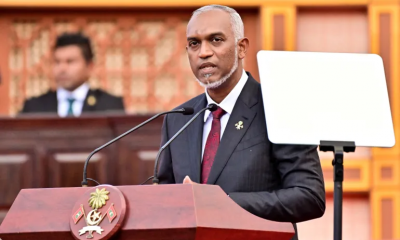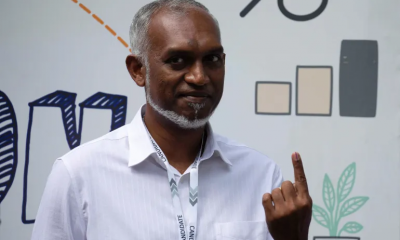Foreign News
The Maldives’ new president wants India out

“We don’t want any foreign military boots on Maldivian soil. I promised this to the people of the Maldives and I will live up to my promise from day one.”
Mohamed Muizzu, who won the Maldives presidential election last month, is wasting no time in asking India to get its troops out of the country.
The president-elect, who is due to be sworn in later in November, told the BBC in an exclusive interview that he met the Indian ambassador a few days after his victory and “told him very clearly that every single Indian military personnel here should be removed”.
The Maldives has long been under India’s sphere of influence and Muizzu’s demand is likely to trigger diplomatic tensions between Malé and Delhi.
In fact, when Muizzu won the Maldives presidential poll, that was seen as a setback for India – especially as his opponent, the incumbent Ibrahim Mohamed Solih – had drawn his country closer to Delhi since taking over in 2018.
The alliance backing Muizzu portrayed this relationship – strengthened by Solih’s India-first policy – as a threat to the Maldives’ sovereignty and security.
Muizzu’s alliance favours closer ties with China, which has invested hundreds of millions of dollars in the Maldives in the form of loans and grants for infrastructure and development projects.
But India, which wants a foothold in the strategically located islands to monitor a key part of the Indian Ocean, has also provided about $2bn in development assistance to the country. If its troops are forced to leave, it will be a blow for Delhi.
But a furore over “gifts” that Delhi gave the Maldives – two helicopters received in 2010 and 2013 and a small aircraft in 2020 – has given the “India out” campaign a huge boost. Delhi said the craft were to be used for search and rescue missions and medical evacuations.
But in 2021, the Maldivian defence force said about 75 Indian military personnel were based in the country to operate and maintain the Indian aircrafts. This fuelled suspicion and anger as many felt the reconnaissance aircraft were being used as an excuse to put Indian boots on the ground.
Muizzu also says that the presence of these troops could put the Maldives at risk – especially as tensions between India and China escalate along their Himalayan border. “Maldives is too small to get entangled with this global power struggle. We will not get entangled into this,” he said.
Speaking to the BBC before the presidential poll, the outgoing president Mr Solih said fears about the presence of Indian troops were exaggerated. “There are no militarily active overseas personnel stationed in the Maldives. Indian personnel currently present in the country are under the operational command of the Maldives National Defence Force,” he said.
But it’s not just the aircrafts. Mr Muizzu said he wanted to review all the agreements the Maldives has signed with India in recent years. “We don’t know what’s in there. Even in Parliament, some of the MPs during the debates said that they didn’t know what’s in there. I am sure we will find it out,” he said.
Soon after his victory, observers noted that the Chinese ambassador in Malé was quick to congratulate Muizzu. Chinese President Xi Jinping also weighed in, saying he attached “great importance to the development of bilateral relations and stands ready to work with President-elect Muizzu to carry forward the traditional friendship, deepen practical cooperation”.
Muizzu has also spoken highly of Chinese infrastructure projects in the Maldives, saying the investments had transformed Malé city and brought benefits to its residents. However, he has denied being a “pro-China” candidate as opposed to the “pro-India” of Mr Solih.”I am a pro-Maldives person. For me, Maldives comes first, our independence comes first” he said. “I am not pro or against any country.”
Despite this, however, his opposition alliance includes the party of former president Abdulla Yameen who was instrumental in moving the Maldives closer to China. When India and Western lenders were not willing to offer loans to Yameen’s administration due to allegations of human rights violations, Yameen – who is currently serving a 11-year prison sentence for corruption – turned to Beijing who offered him the money without any conditions.
He then joined President Xi’s Belt and Road Initiative – which aims to build road, rail and sea links between China and the rest of the world.
Muizzu was seen as a proxy of Yameen – who was barred from contesting the election. Soon after he won the election Muizzu asked the current administration to move Yameen from a high-security prison to house arrest in the capital Male. But given Yameen’s uneasy and tense relationship with Delhi, it could well be a struggle for Muizzu’s new alliance to balance ties with India.
Muizzu sounds keen to emerge out of the shadows of Yameen and is all set to charter a new path both domestically and in the country’s foreign affairs.
Given his decisive victory he may not face much resistance internally, at least in the initial stages. He sounds determined to take the Maldives out of India’s orbit but convincing Delhi to withdraw its troops may be his first big challenge.
(BBC)
Foreign News
Nasa ‘Earthrise’ astronaut dies at 90 in plane crash

Apollo 8 astronaut Bill Anders, who snapped one of the most famous photographs taken in outer space, has died at the age of 90.
Officials say a small plane he was flying crashed into the water north of Seattle, Washington.
Anders’ son Greg confirmed that his father was flying the small plane, and that his body was recovered on Friday afternoon. “The family is devastated. He was a great pilot. He will be missed,” a statement from the family reads.
Anders – who was a lunar module pilot on the Apollo 8 mission – took the iconic Earthrise photograph, one of the most memorable and inspirational images of Earth from space.
Taken on Christmas Eve during the 1968 mission, the first crewed space flight to leave Earth and reach the Moon, the picture shows the planet rising above the horizon from the barren lunar surface.
Anders later described it as his most significant contribution to the space programme.

The image is widely credited with motivating the global environmental movement and leading to the creation of Earth Day, an annual event to promote activism and awareness of caring for the planet.
Speaking of the moment, Anders said: “We came all this way to explore the Moon, and the most important thing that we discovered was the Earth.”
Officials said on Friday that Anders crashed his plane around 11:40PDT (1940BST).
The US National Transportation Safety Board (NTSB) said the 90-year-old was flying a Beechcraft A A 45 – also known as a T-34. The agency said that the plane crashed about 80ft (25m) from the coast of Jones Island.
Anders also served as the backup pilot to the Apollo 11 mission, the name of the effort that led to the first Moon landing on July 24, 1969.
Following Anders’ retirement from the space programme in 1969, the former astronaut largely worked in the aerospace industry for several decades. He also served as US Ambassador to Norway for a year in the 1970s.
But he is best remembered for the Apollo 8 mission and the iconic photograph he took from space.
“In 1968, during Apollo 8, Bill Anders offered to humanity among the deepest of gifts an astronaut can give. He traveled to the threshold of the Moon and helped all of us see something else: ourselves,” Nasa Administrator Bill Nelson said in a statement.
Mark Kelly, a former astronaut who now serves as a US Senator for the state of Arizona, said in a post on X, formerly Twitter, that Anders “inspired me and generations of astronauts and explorers. My thoughts are with his family and friends”.
[BBC]
Foreign News
China’s Chang’e-6 lifts off from far side of Moon with rock samples

A Chinese spacecraft carrying rock and soil samples from the far side of the Moon has lifted off from the lunar surface to start its journey back to Earth, according to state media.
The achievement on Tuesday is a world first and the latest leap for Beijing’s decades-old space programme, which aims to send a crewed mission to the Moon by 2030.
The Xinhua News Agency, citing the China National Space Administration (CNSA), said that the ascender of the Chang’e-6 probe took off at 7:38am local time on Tuesday (23:38 GMT) and entered a preset orbit around the moon.
It described the move as “an unprecedented feat in human lunar exploration history”.
The Chang’e-6 probe was launched last month and its lander touched down on the far side of the Moon on Sunday. It used a drill and robotic arm to dig up soil on and below the Moon’s surface, according to Xinhua.
After successfully gathering its samples, the Chang’e-6 unfurled China’s national flag for the first time on the far side of the Moon, it said.
The agency cited the CNSA as saying that the spacecraft stowed the samples it had gathered in a container inside the ascender of the probe as planned.
[Aljazeera]
Foreign News
China says its spacecraft lands on Moon’s far side

China says its uncrewed craft has successfully landed on the far side of the Moon – an unexplored place almost no-one tries to go.
The Chang’e 6 touched down in the South Pole-Aitken Basin at 06:23 Beijing time on Sunday morning (22:23 GMT Saturday), the China National Space Administration (CNSA) said.
Launched on 3 May, the mission aims to collect precious rock and soil from this region for the first time in history. The probe could extract some of the Moon’s oldest rocks from a huge crater on its South Pole.
The landing was fraught with risks, because it is very difficult to communicate with spacecraft once they reach the far side of the Moon. China is the only country to have achieved the feat before, landing its Chang’e-4 in 2019.
After launching from Wenchang Space Launch Center, the Chang’e 6 spacecraft had been orbiting the Moon waiting to land. The lander component of the mission then separated from the orbiter to touch down on the side of the Moon that faces permanently away from Earth.
During the descent, an autonomous visual obstacle avoidance system was used to automatically detect obstacles, with a visible light camera selecting a comparatively safe landing area based on the brightness and darkness of the lunar surface, the CNSA was quoted as saying by state-run Xinhua news agency.
The lander hovered about 100m (328ft) above the safe landing area, and used a laser 3D scanner before a slow vertical descent. The operation was supported by the Queqiao-2 relay satellite, the CNSA said.
Chinese state media described the successful landing as an “historic moment”. The state broadcaster said “applause erupted at the Beijing Aerospace Flight Control Center” when the Chang’e landing craft touched down on the Moon early on Sunday morning.
The lander should spend up to three days gathering materials from the surface in an operation the CNSA said would involve “many engineering innovations, high risks and great difficulty”. “Everyone is very excited that we might get a look at these rocks no-one has ever seen before,” explains Professor John Pernet-Fisher, who specialises in lunar geology at the University of Manchester.
He has analysed other lunar rock brought back on the American Apollo mission and previous Chinese missions. But he says the chance to analyse rock from a completely different area of the Moon could answer fundamental questions about how planets form.
Most of the rocks collected so far are volcanic, similar to what we might find in Iceland or Hawaii. But the material on the far side would have a different chemistry . “It would help us answer those really big questions, like how are planets formed, why do crusts form, what is the origin of water in the solar system?” the professor says.
The mission aims to collect about 2kg (4.4lb) of material using a drill and mechanical arm, according to the CNSA.
The South Pole–Aitken basin, an impact crater, is one of the largest known in the solar system.
From there, the probe could gather material that came from deep inside the lunar mantle – the inner core of the Moon – Prof Pernet-Fisher says.
The Moon’s South Pole is the next frontier in lunar missions – countries are keen to understand the region because there is a good chance it has ice.

The capsule in the last Chinese moon mission, Chang’e 5, brought back soil and rocks in 2020 (BBC)
Access to water would significantly boost the chances of successfully establishing a human base on the Moon for scientific research.
If the mission succeeds, the craft will return to Earth with the precious samples on board a special return capsule.
The material will be kept in special conditions to try to keep it as pristine as possible.
Scientists in China will be given the first chance to analyse the rocks, and later researchers around the world will be able to apply for the opportunity too.
This is the second time China has launched a mission to collect samples from the Moon.
In 2020 Chang’e 5 brought back 1.7kg of material from an area called Oceanus Procellarum on the Moon’s near side.
China is planning three more uncrewed missions this decade as it looks for water on the Moon and investigates setting up a permanent base there.
Beijing’s broader strategy aims to see a Chinese astronaut walk on the moon by around 2030.
The US also aims to put astronauts back on the moon, with Nasa aiming to launch its Artemis 3 mission in 2026.
(BBC)


















